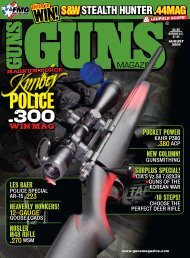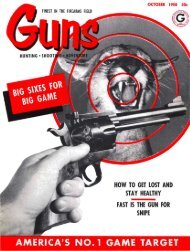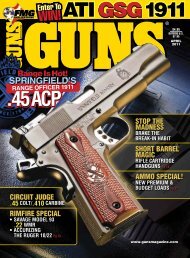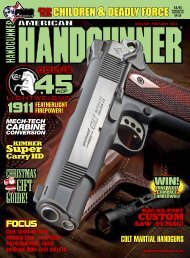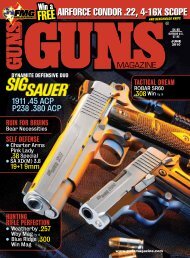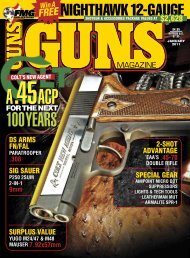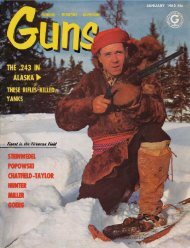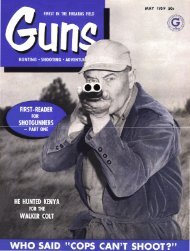NEW! - Jeffersonian
NEW! - Jeffersonian
NEW! - Jeffersonian
Create successful ePaper yourself
Turn your PDF publications into a flip-book with our unique Google optimized e-Paper software.
Simple and fast...<br />
DILLON'S <strong>NEW</strong><br />
RELOADING<br />
PRESS<br />
The RL-450 is a high-volume unit<br />
offered at an affordable price.<br />
By Philip C. Briggs<br />
Deloading is an interesting and satisfyft<br />
ing hobby; but once you experiment<br />
yourself into that one best load for each<br />
pistol, all that's left is cranking out loaded<br />
rounds so you can get in that needed practice.<br />
Or, maybe you only reload so you can<br />
afford to shoot a lot, and the quicker the<br />
loading's done the better.<br />
If you're one of these folks, or for some<br />
other reason need a lot ofammo loaded in<br />
a short time and don't have thousands of<br />
dollars to spend on automatic reloaders,<br />
stick around. Mike Dillon, inventor of the<br />
fantastic RL-lOOO reloader, has deveioped<br />
an equally innovative press-just for you.<br />
The RL-450 is Dillon's second effort at<br />
building a high-volume reloader that the<br />
average shooter/reloader can afford. The<br />
first-the RL-300-had been in production<br />
about a year when Dillon decided he could<br />
do better. The resulting reloader is rated at<br />
a higher cyclic rate-and costs less.<br />
The RL-450 is a large a-frame press<br />
with the a aligned perpendicular to the<br />
front of the bench. It employs a togglelinkage<br />
to develop greater leverages for<br />
more power at the top of the stroke for<br />
sizing cases, and minimal leverage at the<br />
bottom to provide better feel while seating<br />
primers.<br />
The handle has a ball-shaped grip t9<br />
allow operation ofthe handle through fu'il<br />
stroke, without changing your hold. The<br />
ram is quite large in diameter, and it's at<br />
the top where the press is different.<br />
Most turret presses hold multiple dies<br />
and the die holder is rotated to perform<br />
successive operations on a single case.<br />
AMERICAN HANDGUNNER • JANUARYIFEBRUARY 1983<br />
The RL-450, like the RL-300 before it,<br />
uses multiple dies; but they don't rotatethe<br />
cases do. A circular, four-station shdl<br />
holder plate sits on top of the large diameter<br />
ram, and it rotates to bring each case<br />
under a die station. Loading operations<br />
are performed on all four stations, simultaneously.<br />
This is the key to the RL-450s<br />
effortless speed; once the stations are full,<br />
each cycle ofthe handle produces a loaded<br />
round'.<br />
The loading stations are spaced 90 degrees<br />
apart and the first is positioned 45<br />
degrees to the right from the axis of the<br />
O-frame. Empty cases are inserted at the<br />
first station, where they are deprimed and<br />
primed. Bottle neck cases are also expanded<br />
to proper neck diameter at this station.<br />
.<br />
At the second station (to the left),<br />
straight-walled cases are expanded and<br />
flared and all cases are charged with<br />
powder.<br />
Bullets are seated at the third station,<br />
and the cases can be crimped if desired.<br />
The fourth station provides a space for<br />
case crimping, should you prefer to separate"<br />
that operation from bullet seating.<br />
Standard 7/8Xl4 dies are used in<br />
stations one, three and four, and a special,<br />
Dillon-supplied die holds the powder<br />
measure at station two. This die drops<br />
powder into the case through a hollow expander<br />
stem for straight-walled cases, and<br />
through what is essentially a funnel for<br />
bottle-neck dies.<br />
ONLY 20 MINUTES<br />
Changeover to a different cartridge<br />
takes only about 10 minutes for dies, shell<br />
holder, priming punch and feed tube. Add<br />
another 10 minutes or so to adjust the dies<br />
and the measure, and you're ready to load<br />
another box of brass.<br />
A unique primer feeder is mounted on<br />
the front of the press, to the right of the<br />
a-frame, to feed primers into tl;1e priming<br />
punch that is positioned under station one.<br />
Well, that's not quite true, as the priming<br />
punch is on the slide, and it moves; out to<br />
pick up a primer from the feed tube and in,<br />
to its position under station one for primer<br />
seating. This approach eliminates one<br />
transfer of the primer-and one potential<br />
jam.<br />
A powder measure of Dillon's own design<br />
comes with the reloader. It uses an<br />
adjustable slide to meter the charge and<br />
transport it to dump down the drop tube.<br />
Two. charge bars are supplied, large and<br />
small, and the bars ahd measure base are<br />
hard, anodized aluminum alloy for effortless<br />
operation. The measure has to be adjusted<br />
by trial and error as it lacks any<br />
form ofgraduations. This measure is used<br />
on the RL-lOOO and is quite consistent in<br />
charge weights on that machine (as it is on<br />
the RL-450, ifyou develop a machine-like<br />
consistency ofoperation). I finally decided<br />
to give the slide a short rap before cycling<br />
to settle the charge. If I do this, my charge<br />
weights show very small variations. In testing,<br />
the maximum spread was .0 grains for<br />
ten 3.4 grain charges of Bullseye, and .3<br />
grains for ten 24.2 grain charges of HllO.<br />
Oddly enough, I get about the same variation<br />
with short stick powders, such as<br />
H4227 and H4895.<br />
Continued on page 72<br />
37




